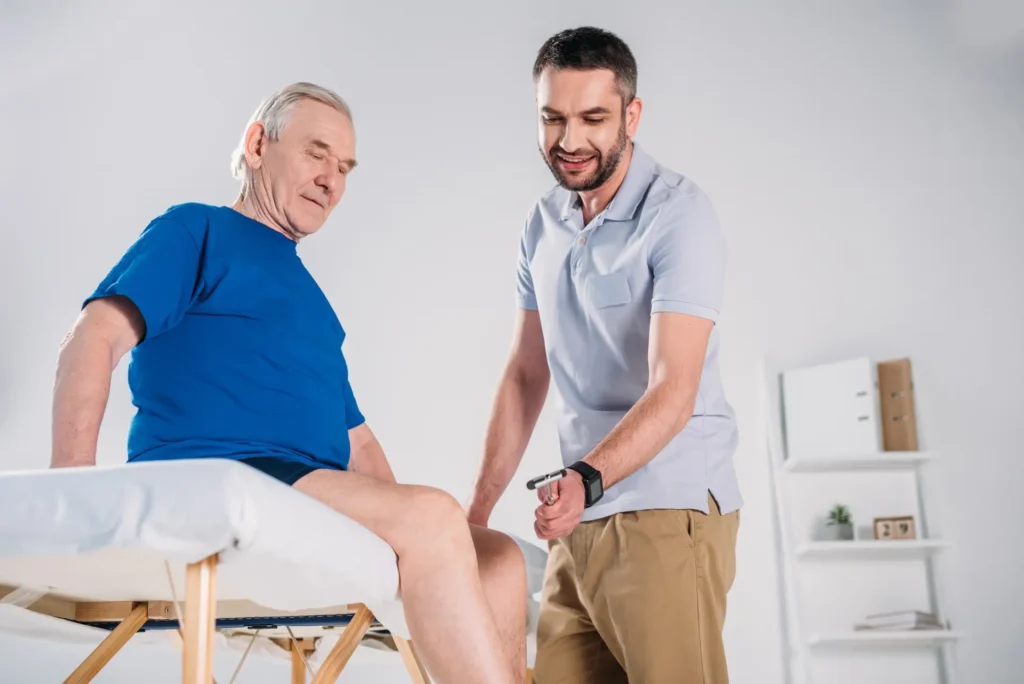The Long Road: Understanding the Timeline of Recovery After Joint Replacement

Joint replacement physiotherapy is also known as postoperative rehabilitation or physical therapy following joint replacement surgery. Joint replacement physiotherapy in Edmonton aims to help individuals recover and regain optimal function after undergoing joint replacement surgery, like hip replacement or knee replacement.
What are the Primary Goals of Joint Replacement Physiotherapy?
Pain Management:
Joint replacement physiotherapy in Edmonton aims to alleviate discomfort and promote the patient’s overall well-being during the rehab process. Some of the pain management strategies commonly used are:
- Ice Therapy: Applying ice packs or cold therapy to the surgical site can help minimize pain, swelling, and inflammation.
- Heat Therapy<: Heat therapy, such as warm compresses or heating pads, can help relax muscles, enhance blood circulation, and alleviate stiffness and discomfort.
- Transcutaneous Electrical Nerve Stimulation (TENS): This involves administering mild electrical currents via electrodes positioned on the skin in proximity to the surgical area.
- Massage Therapy: Gentle massage techniques performed by Momentum physiotherapists help reduce muscle tension, improve circulation, and promote relaxation.
- Manual Therapy: Hands-on techniques performed by our therapist, such as joint mobilizations, soft tissue mobilizations, and stretching exercises.
- Biofeedback: Biofeedback therapy entails utilizing electronic devices to observe and provide feedback on physiological responses such as muscle tension and heart rate.
Restoration of Range of Motion (ROM):
At Momentum physiotherapy, specific exercises and manual techniques are employed to restore range of motion (ROM) in the affected joint. Here are some examples:
- Passive Range of Motion Exercises: In these exercises, our therapist guides the joint through its entire range of motion without external aid.
- Active Range of Motion Exercises: Patients actively move the joint through its full range of motion and promote muscle activation, joint mobility, and proprioception.
- Active-Assistive Range of Motion Exercises: Patients perform joint movements with some assistance using assistive devices, such as a cane or a pulley system.
- Stretching Exercises: Specific stretching techniques target muscles, tendons, and ligaments surrounding the joint to improve flexibility and increase range of motion.
- Joint Mobilizations: This involves applying gentle pressure and controlled movements to the joint surfaces, reducing stiffness, breaking up scar tissue, and improving joint mobility.
- Soft Tissue Mobilizations: These techniques focus on releasing tight or restricted soft tissues, such as muscles, tendons, and fascia, around the joint.
- PNF (Proprioceptive Neuromuscular Facilitation) Techniques: PNF techniques involve a series of stretching and contracting movements performed in a specific sequence to improve flexibility, strength, and coordination.
Joint-Specific Exercises: After knee replacement surgery, exercises such as heel slides, knee bends, and straight leg raises are prescribed.
Gait Training:
The gait training techniques are employed to help patients achieve optimal walking patterns and restore normal gait mechanics after surgery. Here are some techniques used by our physiotherapists:
- Weight-Bearing Exercises: Patients practice shifting weight onto the operated limb while standing and walking.
- Parallel Bars: Patients walk between parallel bars with the assistance of a physical therapist.
- Proper Foot Placement: Emphasis is placed on achieving proper foot placement during each step, including heel strike, midstance, and toe-off.
- Heel-Toe Walking: Patients practice rolling smoothly from heel to toe with each step, promoting a natural gait pattern and facilitating efficient forward movement.
- Balance and Coordination Exercises: Exercises to improve balance and coordination are incorporated into gait training to help patients maintain stability and prevent falls while walking.
- Stair Climbing: Stair climbing exercises help improve lower limb strength, balance, and confidence in negotiating steps safely.
What to Expect During the Recovery Process:
The timeline of recovery after joint replacement surgery, similar to procedures such as total hip replacement or total knee replacement, can help patients manage their expectations and progress through the rehabilitation process more effectively. Here’s a general timeline:
Immediate Postoperative Period (Days 1-3):
- Initial Mobilization: Patients are encouraged to start moving the joint as soon as possible, usually with the help of a physical therapist. This may involve getting out of bed, standing, and taking a few steps with the assistance of walking aids.
Early Recovery Phase (Weeks 1-6):
- Physiotherapy: Formal physiotherapy sessions begin, focusing on regaining the range of motion, strengthening the muscles and joints, and improving mobility. Exercises are typically low-impact and gradually progress in intensity.
Intermediate Recovery Phase (Weeks 6-12):
- Continued Physiotherapy: Rehabilitation sessions become more intensive, focusing on strengthening exercises, functional activities, and improving overall fitness levels.
Advanced Recovery Phase (Months 3-6):
- Return to Normal Activities: Many patients are able to return to light recreational activities and work during this phase, although full recovery may take longer for some individuals.
- Sports and High-Impact Activities: Patients may gradually reintroduce more strenuous activities, like jogging, cycling, or golf, under the guidance of their healthcare team.
Long-Term Recovery (Beyond 6 Months):
- Optimizing Function: While significant progress is typically made within the first six months, continued improvements in strength, mobility, and function may occur for up to a year or more after surgery.
- Maintenance: Patients are encouraged to maintain a regular exercise routine, including activities that promote joint flexibility, muscle strength, and cardiovascular health, to prevent stiffness and reduce the risk of future joint problems.
Navigating the Path to Recovery:
Momentum physiotherapy in Edmonton serves as a vital component in the journey toward recovery and restored mobility for individuals undergoing joint replacement surgery. In essence, joint replacement physiotherapy in Edmonton embodies the transformative power of perseverance and collaboration, paving the way for individuals to embrace life with renewed vitality and purpose.
Book an appointment for a joint replacement physiotherapy session today with our registered physiotherapists and embark on your journey to recovery and enhanced quality of life!
